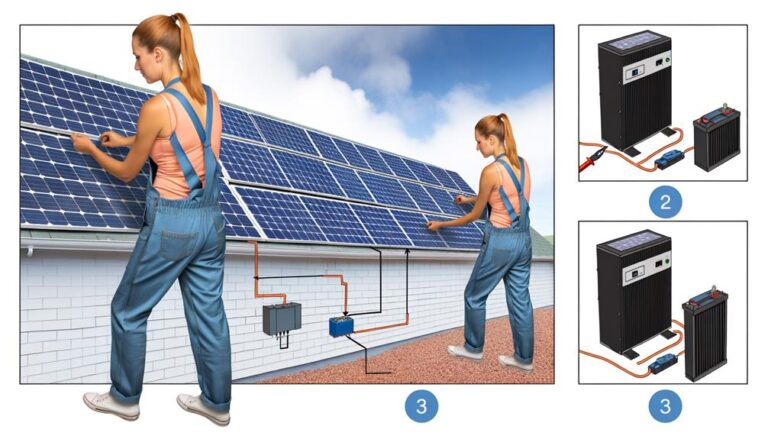11 Microgrid Solutions for Solar Power Grid Integration
Looking to seamlessly integrate solar power into the grid? Look no further. This article presents 11 microgrid solutions for solar power grid integration.
From grid-tied and off-grid microgrid solutions to battery storage integration and demand response management, we’ve got you covered. Explore the possibilities of hybrid microgrid solutions, smart inverters, and microgrid islanding capabilities.
Discover how energy storage optimization and microgrid control and monitoring can enhance your solar power grid integration. Start your journey towards belonging in the world of sustainable energy.
Key Takeaways
- Microgrid solutions can monitor and optimize solar power generation and consumption for seamless integration with the main power grid.
- Off-grid microgrid solutions provide reliable and sustainable electricity to remote communities, reducing carbon emissions and enhancing community resilience during grid outages or natural disasters.
- Off-grid microgrid solutions offer cost-effective energy solutions by utilizing renewable energy options, reducing dependence on fossil fuels, and providing long-term savings on energy bills.
- Integration of battery storage, demand response management, energy management systems, power electronics, and smart inverters is crucial for efficient grid integration and stability, ensuring optimal utilization of resources and enhancing grid reliability.
Grid-Tied Microgrid Solution
If you’re considering a grid-tied microgrid solution, you should frequently monitor your solar power generation and consumption to ensure optimal integration with the main power grid.
Grid-tied microgrid solutions are an effective way to integrate renewable energy into the existing power grid. By connecting your microgrid to the main grid, you can both import and export electricity as needed. This allows you to maximize the use of your solar power generation and minimize reliance on the main grid.
Monitoring your solar power generation and consumption is crucial for maintaining a balance between supply and demand. By analyzing the data, you can identify any inefficiencies or issues and make necessary adjustments. This ensures that your grid-tied microgrid solution operates at its highest efficiency and contributes to a more sustainable and reliable power grid.
Off-Grid Microgrid Solution
Off-grid microgrid solutions offer numerous benefits for remote areas where grid connection isn’t feasible. These solutions provide power reliability advantages, ensuring a continuous supply of electricity even in the absence of a centralized grid.
Additionally, off-grid microgrids offer cost-effective energy solutions, reducing reliance on expensive diesel generators and providing sustainable power options for communities in remote locations.
Benefits of Off-Grid
You can enjoy numerous benefits by implementing an off-grid microgrid solution for solar power grid integration.
One of the key advantages is improved energy access for remote communities. Off-grid microgrid solutions provide a reliable and sustainable source of electricity to areas that are geographically isolated or lack access to traditional power grids. This enables remote communities to have a consistent supply of power for their daily needs, such as lighting, cooking, and communication.
Additionally, off-grid microgrids reduce dependence on fossil fuels and promote environmental sustainability. By harnessing solar power, these solutions offer a clean and renewable energy source that reduces carbon emissions and mitigates climate change.
Moreover, off-grid microgrids enhance community resilience by providing energy independence and ensuring continuity during grid outages or natural disasters.
Power Reliability Advantages
By implementing an off-grid microgrid solution for solar power grid integration, you can ensure enhanced power reliability. Here are three key advantages of this approach:
Power quality improvements:
Off-grid microgrids provide better control over power quality, minimizing voltage fluctuations and reducing the risk of power surges or outages. This ensures a more stable and reliable power supply for your solar energy system.
Grid stability enhancements:
Off-grid microgrids are designed to operate independently from the main power grid. This means that even during grid failures or blackouts, your solar power system can continue to generate and supply electricity to your facility. This significantly improves the overall stability of your power supply.
Increased resilience:
With an off-grid microgrid solution, you can achieve greater resilience against external disruptions such as natural disasters or grid failures. By having a self-sustaining power system, you can maintain power reliability even in challenging situations, ensuring uninterrupted electricity supply for critical operations.
Implementing an off-grid microgrid solution offers significant power reliability advantages, including power quality improvements, grid stability enhancements, and increased resilience.
Cost-Effective Energy Solutions
Implementing an off-grid microgrid solution for solar power grid integration offers a cost-effective energy solution. By utilizing renewable energy options, such as solar power, off-grid microgrids provide an efficient and sustainable alternative to traditional power grids.
These cost-effective solutions not only reduce dependence on fossil fuels but also offer long-term savings on energy bills. Off-grid microgrids can be tailored to the specific energy needs of a community or facility, ensuring optimal utilization of resources and minimizing waste.
To demonstrate the potential cost savings, consider the following table showcasing a comparison of the initial setup costs and annual savings of an off-grid microgrid solution compared to a traditional grid connection:
| Initial Setup Cost ($) | Annual Savings ($) | |
|---|---|---|
| Off-grid Microgrid | $50,000 | $10,000 |
| Traditional Grid | $100,000 | $5,000 |
As shown, the off-grid microgrid solution not only requires a lower initial investment but also provides higher annual savings, making it a viable and cost-effective choice for sustainable energy solutions.
Hybrid Microgrid Solution
When considering the benefits of hybrid microgrids, it’s important to assess their ability to combine multiple energy sources such as solar, wind, and diesel generators. This integration allows for increased reliability and flexibility in power generation, ensuring a more resilient system.
However, the implementation of hybrid microgrids may pose challenges such as system complexity, equipment compatibility, and control coordination. Finding solutions to these challenges is crucial for the successful deployment and operation of hybrid microgrid solutions.
Benefits of Hybrid Microgrids
Maximizing renewable energy integration is achieved through the use of hybrid microgrids, offering numerous advantages for your solar power grid. These benefits include:
- Enhanced Grid Resilience: Hybrid microgrids provide increased resilience to power outages and disruptions. By combining multiple energy sources, such as solar, wind, and battery storage, they can ensure a consistent and reliable power supply, even during extreme weather events or grid failures.
- Optimal Renewable Energy Utilization: Hybrid microgrids intelligently manage and optimize the use of renewable energy sources. They can seamlessly switch between different energy sources based on availability, demand, and cost, maximizing the utilization of renewable energy and reducing reliance on fossil fuels.
- Cost Savings and Energy Efficiency: By integrating renewable energy sources, hybrid microgrids can significantly reduce energy costs and improve energy efficiency. They allow for better control and management of energy consumption, leading to lower electricity bills and a more sustainable energy future.
Implementation Challenges and Solutions
To overcome the challenges of integrating hybrid microgrids into solar power grids, you can address key implementation obstacles and find effective solutions.
One major challenge is the implementation strategy itself. Developing a comprehensive plan that takes into account the technical aspects of integrating multiple energy sources, such as solar, wind, and storage, requires careful consideration and expertise.
Additionally, regulatory hurdles can pose significant challenges. Navigating through complex regulations and obtaining the necessary permits and approvals can delay the implementation process.
To overcome these challenges, you can employ several solutions. Firstly, investing in research and development to improve the efficiency and reliability of hybrid microgrid systems can help streamline the implementation process.
Secondly, collaborating with regulatory authorities and stakeholders to develop streamlined regulatory frameworks can expedite the integration of hybrid microgrids into solar power grids.
Battery Storage Integration
Ensure seamless integration of battery storage into solar power grids to optimize energy management and enhance grid reliability. To achieve this, consider the following:
- Battery Management Systems (BMS): Implement advanced BMS technology to monitor and control battery performance. This allows for efficient charging and discharging, prolonging battery life and maximizing energy storage capabilities.
- Renewable Energy Integration: Integrate battery storage with renewable energy sources, such as solar power, to effectively capture and store excess energy. This promotes a more sustainable and reliable electricity supply, reducing dependence on traditional fossil fuel-based power generation.
- Grid Stability and Resilience: Utilize battery storage to enhance grid stability during peak demand or intermittent renewable energy generation. By providing rapid response and frequency regulation services, battery storage helps maintain a stable grid, reducing the risk of power outages and improving overall system resilience.
Demand Response Management
To ensure optimal energy management and grid reliability, integrating demand response management into the battery storage integration of solar power grids is essential.
Demand response management plays a crucial role in enhancing the efficiency of solar power grid systems. It involves coordinating and adjusting energy consumption in response to supply and demand fluctuations.
By implementing demand response strategies, such as load shedding, you can optimize energy consumption and reduce peak demand on the grid. Load shedding strategies involve temporarily reducing non-essential energy loads during periods of high demand, allowing for better utilization of available energy resources.
This helps to ensure grid stability and reliability, while also reducing the need for additional power generation capacity.
Energy Management System
How can you effectively manage the energy in your solar power grid using an energy management system?
An energy management system (EMS) is a key tool for optimizing energy usage and load management in a solar power grid. Here are three ways an EMS can help you achieve energy optimization and efficient load management:
- Real-time monitoring and control: An EMS allows you to monitor energy generation, consumption, and storage in real-time. This enables you to make informed decisions about load balancing, energy storage, and demand response.
- Load forecasting and scheduling: With an EMS, you can analyze historical data and use advanced algorithms to forecast load patterns. This helps in scheduling energy generation and consumption to ensure optimal utilization of available resources.
- Demand response coordination: An EMS facilitates demand response programs by automatically adjusting energy consumption during peak demand periods. This not only helps in reducing strain on the grid but also provides financial incentives to the grid operator and end-users.
Power Electronics Integration
Can an energy management system effectively integrate power electronics into your solar power grid?
Power electronics play a crucial role in the efficient integration of renewable energy sources, such as solar power, into the grid. By converting and controlling the flow of electrical energy, power electronics enable the seamless integration of solar power into the grid, ensuring maximum power output and efficiency.
They facilitate the optimal transfer of power between the solar panels, energy storage systems, and the grid. Power electronics also enable grid stability by managing voltage and frequency fluctuations that can occur due to the intermittent nature of solar power generation.
Integrating power electronics into your solar power grid is essential for maximizing power generation, improving efficiency, and ensuring the successful integration of renewable energy into the existing grid infrastructure.
Smart Inverters for Grid Integration
You can integrate smart inverters into your solar power grid to enhance grid integration and optimize power generation. Smart inverters are advanced devices that can communicate with the grid and other solar energy systems, allowing for better coordination and control of power flow.
Here are three key benefits of using smart inverters for grid integration:
- Improved Grid Stability: Smart inverters can actively manage power fluctuations and voltage variations, helping to maintain a stable grid. They can also provide reactive power support, enhancing grid reliability during periods of high solar generation.
- Enhanced Power Quality: Smart inverters can regulate the voltage and frequency of the electricity they generate, ensuring a consistent and reliable power supply. This helps prevent voltage sags, spikes, and harmonic distortions that can affect the performance of connected devices.
- Advanced Monitoring and Control: Smart inverters can enable smart metering and advanced communication capabilities, allowing for real-time monitoring and control of solar power generation. This helps utilities and system operators better manage and optimize the integration of solar energy into the grid.
Microgrid Islanding Capabilities
Microgrid islanding capabilities provide numerous benefits for grid independence, ensuring a reliable power supply and enhancing resilience during outages. By allowing microgrids to operate independently from the main grid, they can continue to supply power even when the larger grid is experiencing disruptions.
This capability not only improves energy security but also enables the integration of renewable energy sources, such as solar power, into the grid without compromising reliability.
Grid Independence Benefits
Achieve grid independence with the help of microgrid islanding capabilities. Microgrids offer several advantages in terms of grid independence and renewable energy integration. Here are three benefits of microgrid islanding capabilities:
- Increased reliability: By allowing a microgrid to operate independently from the main grid, it can continue to provide power even during grid outages. This enhances the reliability of the energy supply, ensuring that critical facilities such as hospitals, military bases, and remote communities have continuous access to electricity.
- Enhanced renewable energy integration: Microgrid islanding capabilities enable the seamless integration of renewable energy sources, such as solar and wind power, into the grid. The flexibility of microgrids allows for effective management of intermittent renewable energy generation, maximizing its utilization and reducing reliance on traditional fossil fuel-based power generation.
- Improved energy efficiency: Microgrids enable localized energy generation and consumption, reducing transmission losses associated with long-distance power transmission. By utilizing distributed energy resources efficiently, microgrids can achieve higher energy efficiency levels, resulting in cost savings and reduced environmental impact.
Reliable Power Supply
With microgrid islanding capabilities, you can ensure a reliable power supply even during grid outages. Microgrids offer an innovative solution by integrating solar power into the existing grid infrastructure, providing backup power solutions when the grid fails.
By utilizing advanced control systems, microgrids can detect grid disturbances and seamlessly disconnect from the main grid, creating an islanded mode. In this mode, the microgrid can continue to generate and distribute power independently, relying on its renewable energy sources like solar panels.
This capability ensures that critical facilities such as hospitals, schools, or residential areas can maintain a continuous power supply, minimizing disruption and enhancing the overall reliability of the system.
Resilience During Outages
Ensure a reliable power supply during grid outages by utilizing microgrid islanding capabilities. Resilience planning is crucial for maintaining energy supply in the face of disruptions. Microgrids offer an effective solution by allowing selected areas to disconnect from the main grid and operate independently.
Here are three key benefits of microgrid islanding capabilities:
- Enhanced reliability: During power outages, microgrids can continue providing electricity to critical loads, such as hospitals, emergency services, and communication networks. This ensures essential services remain operational, improving community resilience.
- Quick restoration: Microgrids equipped with backup power solutions, such as energy storage systems or backup generators, can swiftly restore electricity supply after an outage. This minimizes downtime and disruption for businesses and households.
- Reducing dependence on the main grid: By operating independently, microgrids reduce reliance on the main grid, making the energy supply more resilient and less susceptible to widespread outages caused by natural disasters or other emergencies.
Implementing microgrid islanding capabilities is an effective strategy for ensuring a reliable power supply during grid outages.
Energy Storage Optimization
Optimize energy storage to enhance the integration of solar power into the microgrid.
Energy storage optimization plays a crucial role in effectively integrating solar power into microgrids. By efficiently managing energy storage, you can ensure a reliable and stable power supply, even during periods of low solar generation.
Demand response management is an essential component of energy storage optimization. It allows for the intelligent coordination of energy storage systems to respond to fluctuations in energy demand and supply. By implementing demand response strategies, you can maximize the utilization of renewable energy sources, such as solar power, while minimizing reliance on the main grid.
This optimization also enables grid operators to maintain grid stability and avoid overloading or blackouts.
Microgrid Control and Monitoring
You can effectively monitor and control your microgrid system to ensure efficient integration of solar power. By implementing robust control and monitoring mechanisms, you can optimize the performance of your microgrid and enhance its reliability.
Here are three key aspects to consider:
- Real-time monitoring: Utilize advanced monitoring systems to collect data on various parameters such as power output, load demand, and battery storage levels. This real-time information allows you to make informed decisions and respond promptly to any fluctuations or issues.
- Control algorithms: Develop intelligent control algorithms that can regulate the flow of power within the microgrid. This ensures optimal utilization of solar energy and efficient distribution among connected loads, maximizing the overall system performance.
- Cybersecurity measures: Implement robust cybersecurity protocols to protect your microgrid from potential threats. With the increasing connectivity of microgrids, it’s crucial to safeguard against cyber-attacks that could disrupt the system’s operation and compromise the security of microgrid energy sharing.
Conclusion
Congratulations! You have just explored 11 amazing microgrid solutions for integrating solar power into the grid.
From grid-tied and off-grid solutions to hybrid systems and battery storage integration, these options offer reliable and efficient ways to harness the power of the sun.
With advanced technologies like demand response management, smart inverters, and microgrid control and monitoring, we can optimize energy storage and ensure seamless grid integration.
So, get ready to embrace the future of sustainable energy with these innovative microgrid solutions.






